How to become a recommended solution provider on Google entity lists
In this article, you will learn how to leverage the eight main factors that will get your company (or yourself) explicitly recommended by Google’s knowledge algorithms in search.
The target (and the key performance indicator) is that your named entity is included in the “best of” entity lists on Google search – a list of solutions Google explicitly recommends to users.
If you successfully implement this strategy for Google’s “best of” entity lists, you will also dominate recommendations from Google Gemini, Microsoft Copilot, ChatGPT, Perplexity and other AI assistive engines.
What is a ‘best of’ entity list in Google search?
A “best of” entity list in Google search is a list in the search results answering user search queries that explicitly or implicitly ask Google to provide its “opinion” about the top solution providers for a specific topic, field or problem.
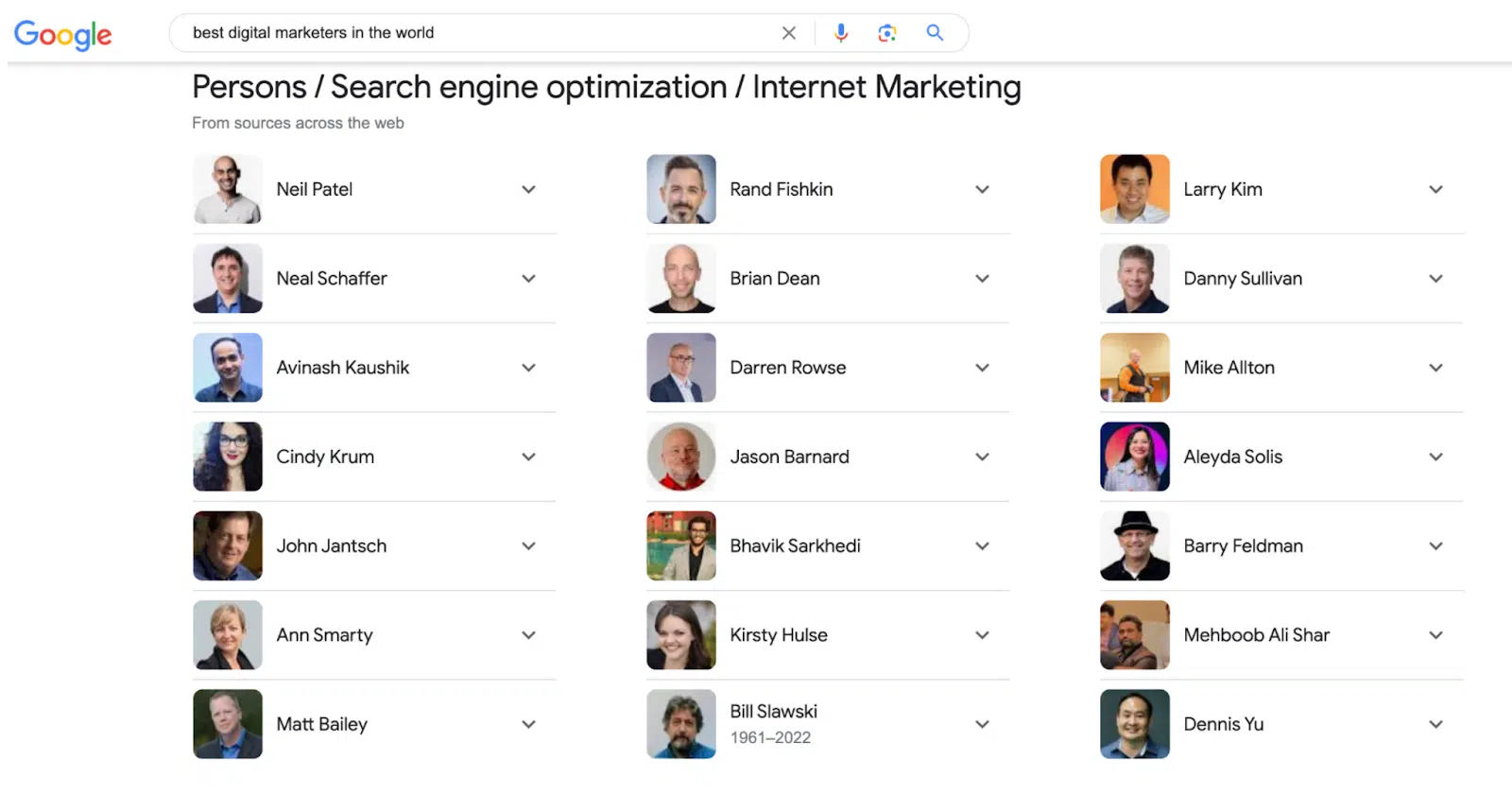
Google’s approach to answering a “best of” query has changed significantly. Google has traditionally presented someone else’s opinion of “the best” in the form of blue links, videos and lists in featured snippets.
Today, Google search and Gemini have their own opinion based on their algorithmic assessment of “the best.”
The result is no longer based on simple links and keywords. It is an amalgamation of multiple third-party sources, large language models, the Knowledge Graph and its algorithmic evaluation of the N-E-E-A-T-T credibility of the possible solution providers.
Why is it essential to be included in ‘best of’ entity lists in Google search?
Before reading the rest of this article, focus on this simple and powerful idea: People use Google because they trust it to be the most efficient way to find the best solution to their problems.
That means Google is a recommendation engine. Its sole aim is to recommend the best, most efficient solution to the user’s problem.
SEO boils down to this. Every tactic you implement to rank on Google attempts to convince it to recommend you to its users as the preferred solution provider.
Google’s role as a recommendation provider and the scale of its influence make it far and away the most important “influencer” you can possibly imagine. Every day, it has billions of hyper-niche conversations with users who trust its advice and will follow its recommendations.
Entity lists are Google’s explicit recommendations for the best solutions to users’ problems and where Google becomes a trusted advisor and direct “influencer.”
Entity lists are replacing blue links, universal search and featured snippets as the prime spots for “best of” queries in Google search. That is a great short-term SEO win for you.
Entity lists are the foundation for your future SEO
The future of search is grounded on Knowledge Graphs (machine-readable knowledge repositories).
Being “understood” and included in Google’s Knowledge Graph is your only long-term hope of participating in the conversation with AI assistive engines.
Entity lists are a great KPI today because the presence of your entity in these lists demonstrates the following things.
- Understandability: Google has understood who you are, what you do and who you serve
- Credibility: Google’s positive assessment of your E-E-A-T (N-E-E-A-T-T) credentials
- Deliverability: You are sufficiently omnipresent across the relevant digital ecosystem for Google to take you seriously as a solution it can confidently recommend.
They are also a great predictive KPI since your presence in “best of” entity lists demonstrates that you have nailed understandability, credibility and deliverability.
This indicates that you are on track with strategies targeting assistive search features (such as AI Overviews and Microsoft Copilot) and assistive engines (like ChatGPT and Google Gemini).
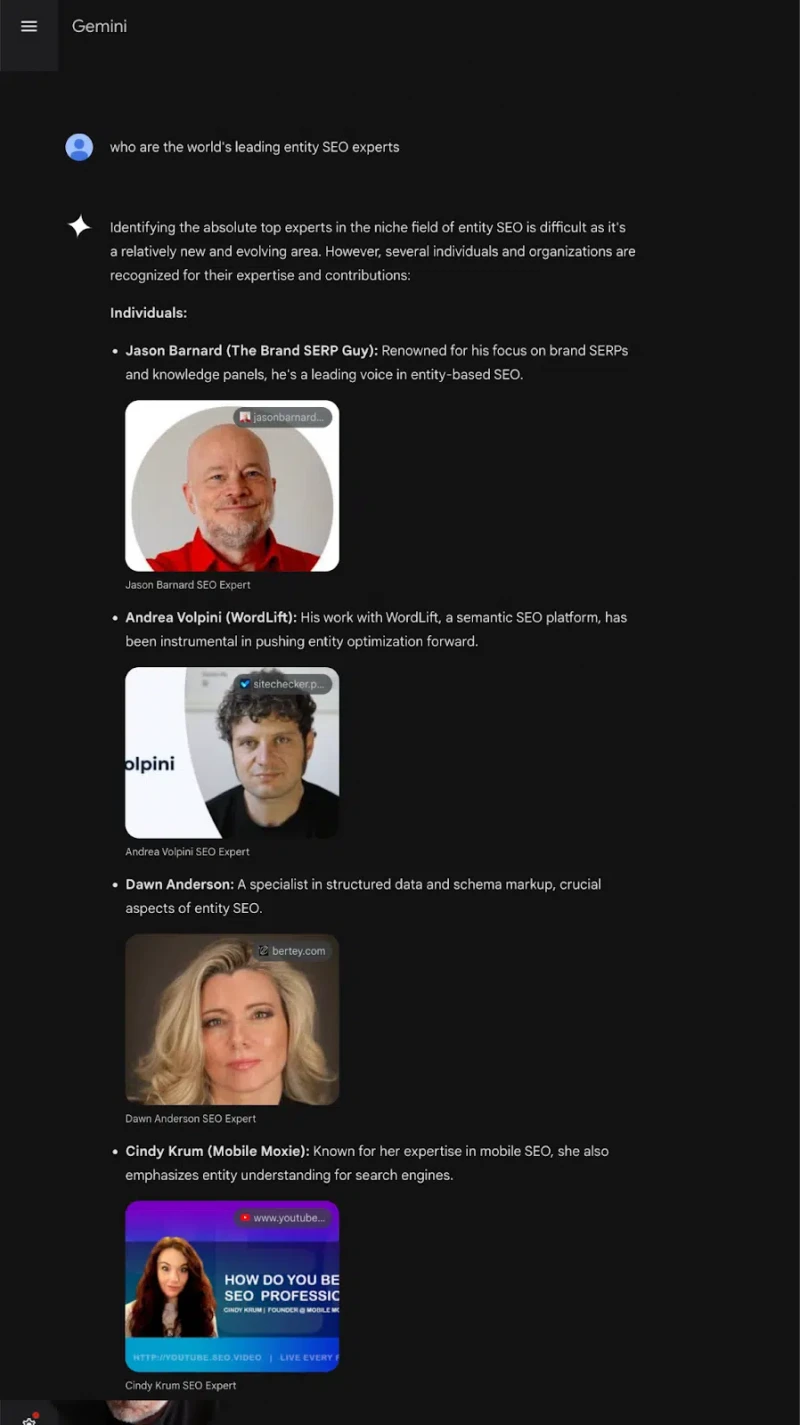
The way Google recommends has changed over the years
When I started in SEO in 1998, being Google’s top choice meant ranking first in the search results.
With the introduction of universal search, the opportunities expanded as Google began recommending the best videos, images, local businesses, news and more.
‘Best of’ featured snippets
More recently, featured snippets (a.k.a. position zero) became a more explicit recommendation.
For “best of” queries, Google often uses featured snippets, pulling a list from a single page on a website that it feels answers the user’s request for an explicit list of “the best.”
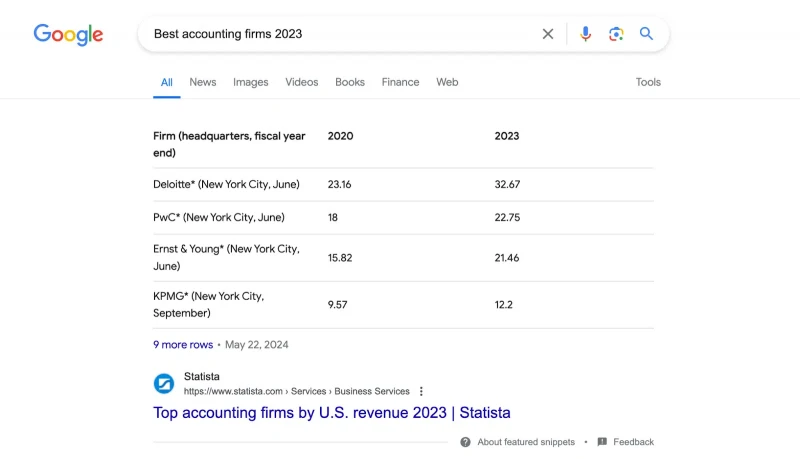
The SEO strategy to be listed on Google search in a featured snippet “best of” list is simple: get your entity included in relevant lists curated by an expert, industry blog or even on your website.
Luckily for all of us, the simple featured snippet strategy of earning a place in a human-curated list is one of the eight levers you can use for entity lists. But it is no longer a standalone solution.
‘Best of’ entity lists
Google’s introduction of entity lists has changed the game. Google is now compiling its own list of the best in the market, explicitly recommending specific solutions to its users.
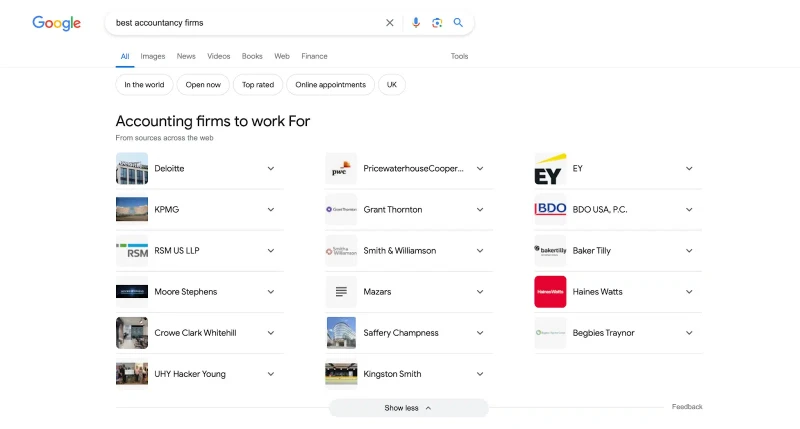
This article provides additional insights into how they are built, strategies you can implement and key performance indicators (KPIs) you can show your boss or client.
Featured snippets still work, but not for long
When the query becomes too specific, and Google cannot compile the list itself from knowledge, Google reverts to featured snippets. Featured snippets will become increasingly rare as Google grows its Knowledge Graph.
For example, as Google confidently understands the revenue for the accountancy firms in Canada, it will compile its own list and present an entity list rather than this featured snippet:

Google has proactively presented the filter “By revenue” because the algorithms understand that users find this attribute useful.
You can be sure that Google’s knowledge algorithms are actively looking to add this information to its Knowledge Graph for as many firms as possible to replace the featured snippet with their own list (and keep the user on the SERP).
How can I be included in a ‘best of’ entity list in Google search?
Using the strategies and tactics I explain in this article, you can be included in a “best of” entity list in a Google search today and “best of” conversations in assistive/answer engines tomorrow.
These simple, timeless strategies focus on delivering top value to your audience and clearly communicating that to Google and other Big Tech AI algorithms.
By consistently sharing facts about yourself and demonstrating your competitive edge across your digital presence, you can convince both your audience and search engines that you are the best solution.
Consistently showcasing your dominant position within your market ensures you always win the game, whether with your human audience or Google.
One challenge we all face when optimizing for Knowledge Graphs, LLMs and AI knowledge algorithms is the lack of KPIs. You probably feel that you are flying blind, which can be frustrating.
However, numerous KPIs are available to gain insights into what the AI “thinks,” identify the next steps and track your progress. I will provide a simple visual KPI for each of the eight levers.
Note: The KPIs described in this article are simple visual representations. In my company, we track data at scale and base our KPI on our 2 billion+ data points.
How to optimize for ‘best of’ entity lists
The following approach and principles may also work for assistive engines, LLMs and Knowledge Graphs.
- Get a Knowledge Panel for your entity.
- Communicate as many attributes as possible (revenues, country, number of employees, etc.).
- Get users talking about you.
- Get included in as many industry/expert “best of” lists.
- Build association with relevant topics.
- Build relationships with relevant entities.
- Improve and communicate your E-E-A-T credibility.
- Build niche notability (taking E-E-A-T to a new level with N-E-E-A-T-T).
Implementing all eight levers will help you appear in relevant “best of” entity lists and be recommended by assistive engines and search features.
1. Get a Knowledge Panel for your entity (person or corporation)
The prerequisite for being included in any list of entities (such as “Best of,” “Related” or “People also search for”) is to be explicitly recognized as a named entity in one of Google’s Knowledge Graphs.
Start by securing a Knowledge Panel on Google for your entity. Without explicit recognition in a Knowledge Graph, you’re not even in the game.
I cannot emphasize enough that if you don’t successfully complete this step and build an information-rich Knowledge Panel, the rest won’t work.
If you already have a Knowledge Panel, you must focus on building Google’s confidence in its understanding: the more confident it is, the more likely it will add you to an entity list.
The KPI for this foundational step is having a Knowledge Panel for the entity.
The KPI for confidence in understanding is that the Knowledge Panel reliably triggers the brand SERP over the years, like mine.
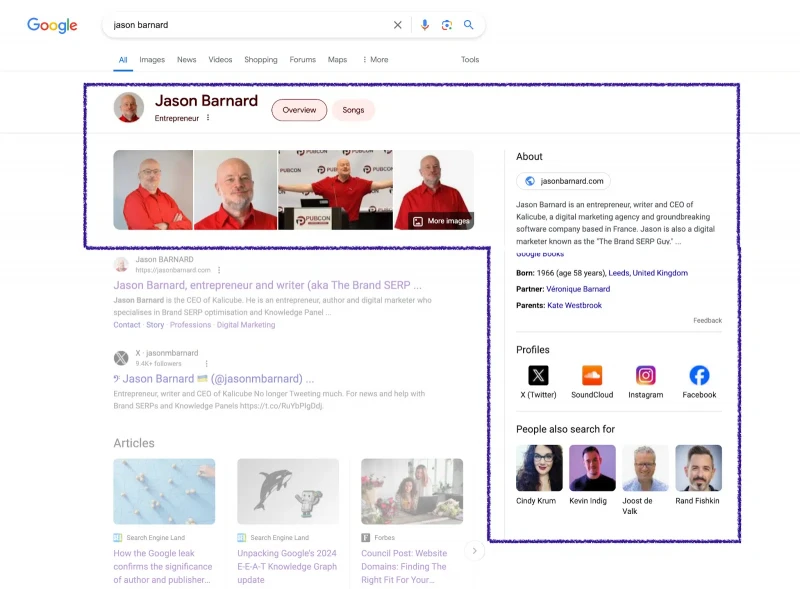
2. Communicate as many attributes as you can
The more attributes you can feed into Google’s “brain,” the better. The more attributes Google understands, the more lists it will include you in.
Use the filter pills at the top of search results to identify the best candidates: revenues, country, number of employees, etc.
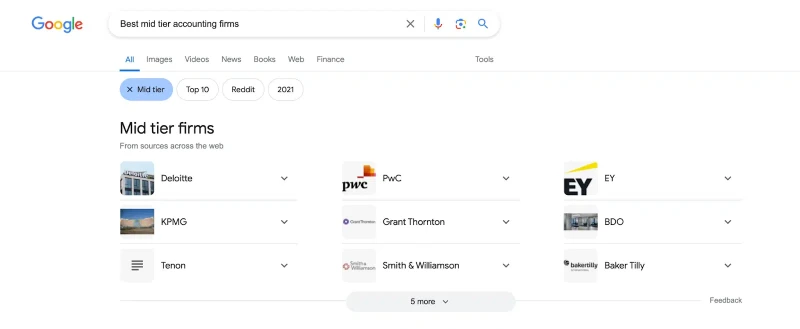
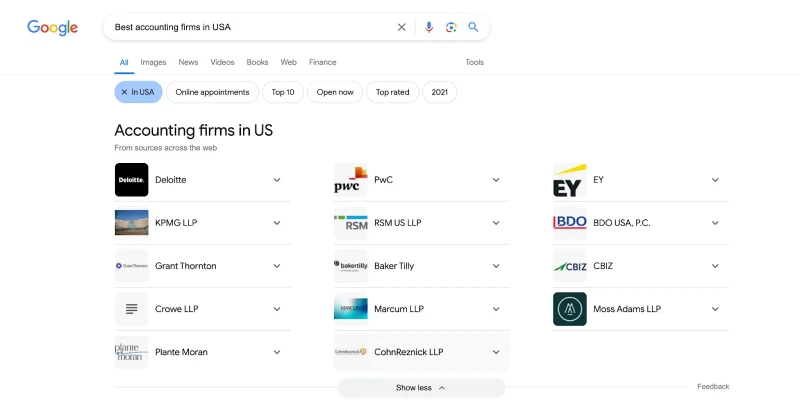
You can feed attributes into the Knowledge Graph by stating them clearly on your entity home in the form of semantic triples and structured data and ensuring the information you provide is corroborated by multiple authoritative sources online.
Warning: More corroboration is not necessarily better. Clarity of communication, accuracy of information and relevancy of the source are key.
Some good KPIs for this are attributes appearing in the Knowledge Panel (in my personal Knowledge Panel above: date of birth, partner, mother) and the featured snippet and knowledge results for attribute-focused search queries:
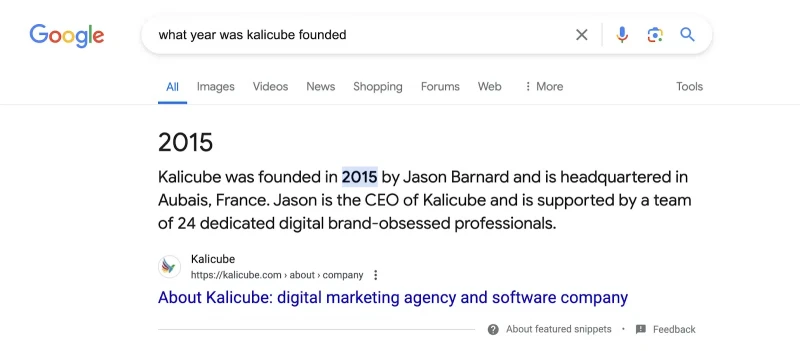
3. Get users talking about you
For years, Google has been extracting masses of hyperspecific information from user-generated content (UGC):
- Client reviews.
- Forums.
- User feedback on your website.
- Social media.
- Tutorials.
- Blog posts.
- Fan sites.
The list goes on and on.
If Google is confident it understands your entity (see the Knowledge Panel KPI above), then Google will probably figure out the user is talking about you.
Your audience’s information can be used to understand additional attributes and relationships. That means UGC is a powerful way to feed Google’s knowledge algorithms.
Warning: Be prudent. The danger is that users are unreliable and can muddy the waters with inaccurate information or contribute to a bad reputation with negative comments and reviews (which can exclude you from the “best of list”).
A simple KPI is the accuracy, verbosity and sentiment of Gemini’s reply to the question “What do people think about {brand}?”
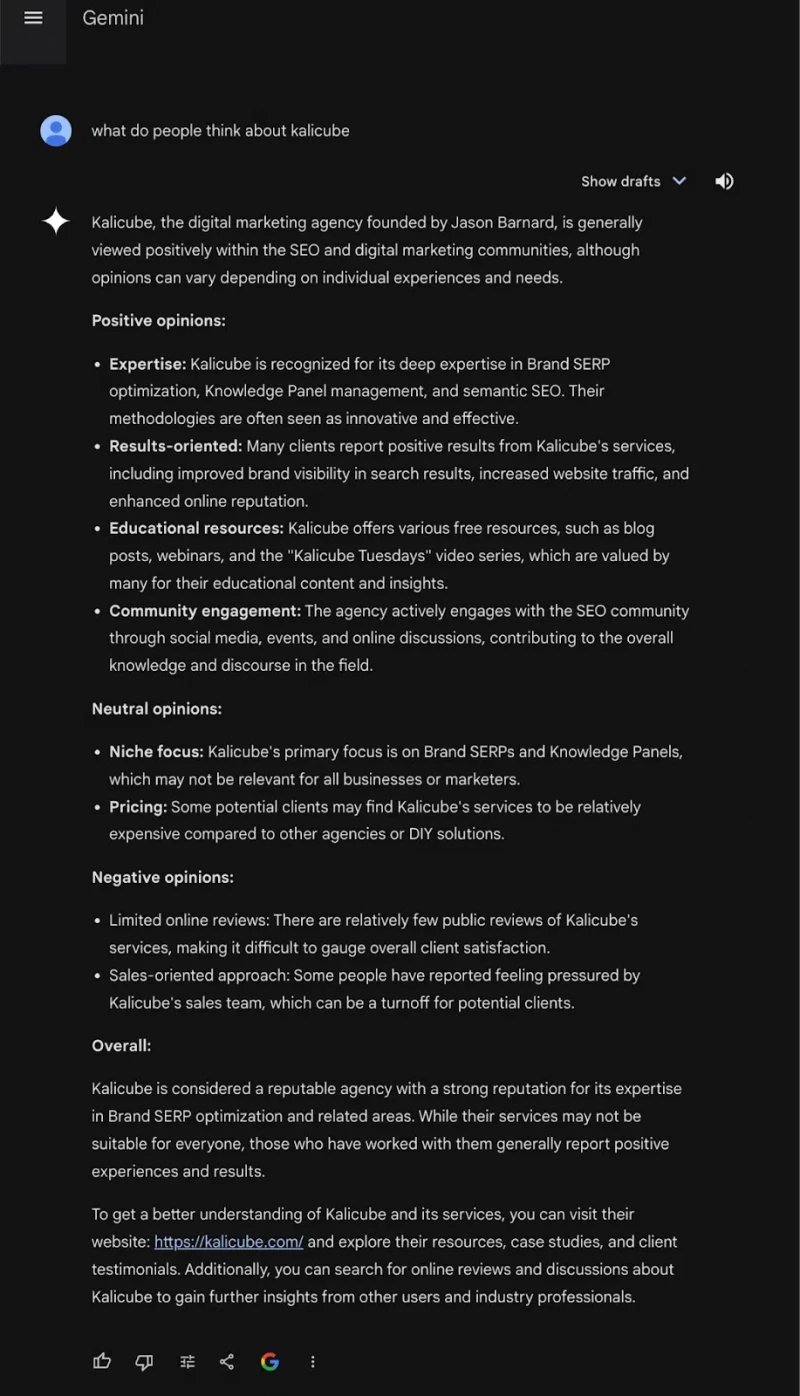
4. Get included in as many industry / expert ‘best of’ lists
The more your entity appears in relevant lists from authoritative sources in your industry, the better it will perform in Google’s entity lists.
Additionally, lists focusing on specific attributes such as year, company size, number of employees, country or state will enhance performance in filtered lists on Google alongside general lists.
This strategy has the bonus of landing you some featured snippets, a fantastic short-term win to showcase to your client or boss.
A KPI for “best of” lists is the lists themselves and also seeing them in your entity list entry like this:

5. Build association with the topics that are highly relevant to the target lists
Work intentionally to ensure that Google associates your named entity with the topic that triggers relevant Entity lists.
To achieve this, publish topically relevant content on your entity home (i.e., website) and other platforms where you can directly post, such as LinkedIn, YouTube and Medium. Ensure the content comprehensively covers core topical concepts of your named entity.
Engage in topically relevant guest posting, social media interactions and participation in hyper-focused forums like Reddit to strengthen Google’s association with your entity and the topic in its Knowledge Graph.
A simple KPI here is the associated topics in Google images.

Another is the AI Overviews results for the query “{brand} topics.”
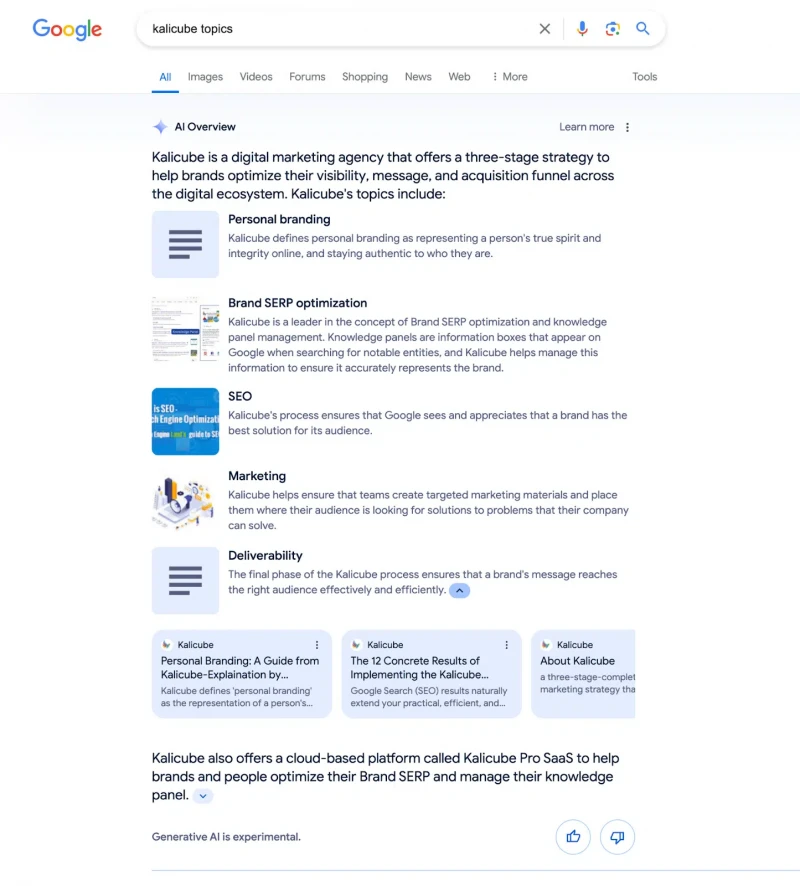
6. Build relationships with the entities in your target lists
Barnacling will help you get your entity into relevant entity lists.
If Google already understands and appreciates entities within your industry, any association with them will help you in that niche.
Identify prominent entities with whom you have a relationship (the closer, longer, stronger, the better) and then communicate your relationships with them to Google.
To communicate these relationships to Google, create content on your entity home website highlighting these connections.
Clearly indicate the type of relationship (e.g., partnership), its strength (e.g., long-term collaboration) and its closeness (e.g., direct involvement).
Link this content to relevant and authoritative third-party websites that corroborate the relationship. The ultimate and most powerful signal is when the target entity confirms the relationship on its Entity Home website.
Building relationships with the entities on relevant entity lists is another strategy. Networking with other entities makes sense from a networking and business perspective and will pay off handsomely – with or without Google.
A good KPI for this is “People also search for” (yours and theirs).

7. Improve and communicate your E-E-A-T credibility
When Google understands that you are an expert, experienced, authoritative and trustworthy within your industry (and topic), it is confident it can safely recommend you as a solution for its users and include you in a “best of” entity list, which is a no-brainer.
To ensure Google “gets” how E-E-A-T (in)credible you are, ensure that your website and all of your digital ecosystem clearly showcase your expertise, experience, authoritativeness and trustworthiness.
Clearly express information that supports your claim to be expert, experienced, authoritative and trustworthy.
Then, encourage your peers, clients and audience to corroborate and confirm through social media, reviews, testimonials, articles, etc.
Your KPI is the sentiment and accuracy of the brand SERP, the quality of the results for the search query “{brand} reviews” and the sentiment of Gemini’s reply to the question “What do you think about {brand}”, like this:
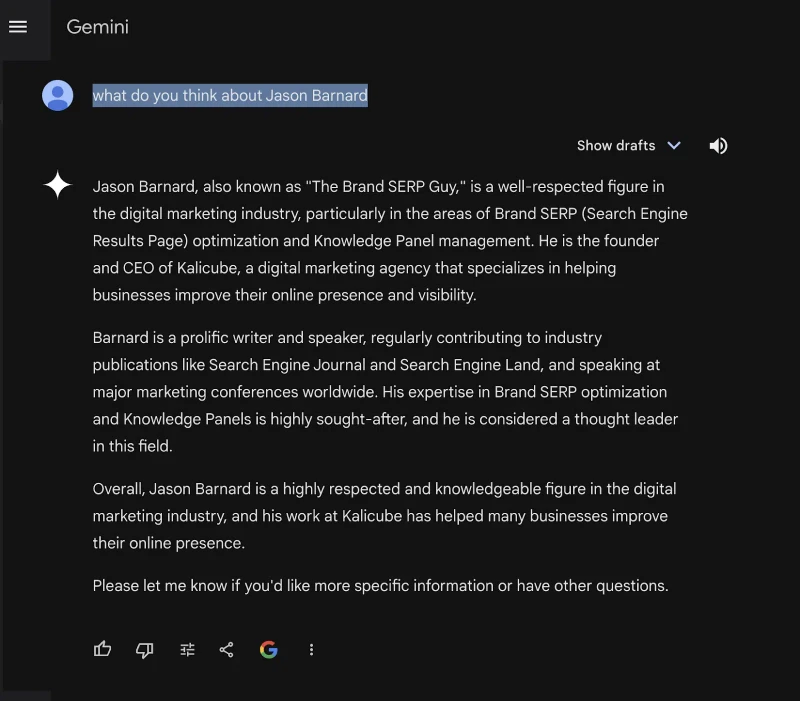
Notice the terms “well-respected,” “sought-after” and “thought leader.” Does your named entity get that enthusiastic treatment?
8. Build niche notability
Niche fame will get you to the top of every relevant list that is valuable to your business. Neil Patel gets first place in almost all lists of the best / leading / top digital marketing experts because he is famous.
Google doesn’t talk about notability as a signal. Still, our internal data clearly shows that niche notability is incredibly powerful in assistive Engine results, be it Gemini, Copilot, ChatGPT, Perplexity or any other.
To build niche notability, put your entity out there front and center.
Engage in online activities like social media, paid ads and guest posting while participating in offline events.
(Obviously, Google doesn’t see anything offline, so be sure to bring these offline activities online by sharing them on social media, adding information to your website, making videos, etc.)
Ultimately, being famous will increase the volume of branded searches, so you can use that as your KPI for notability.

Entity optimization is the future of SEO
If you implement these eight strategies for a named entity, you have a great chance of dominating your niche.
Without confident understanding (represented by a Knowledge Panel on the brand SERP) you are not in the game.
If you cannot demonstrate N-E-E-A-T-T credibility, then Google (or other AI engines) cannot recommend you as a solution provider.
Your inclusion in relevant “best of” entity lists on Google search today demonstrates that you have nailed the three keys to modern SEO: understandability, credibility and deliverability.
Traditional SEO is now only one-third of a modern SEO strategy. 2024 will prove to be a watershed where the three-tiered approach to SEO I have championed over the years becomes the norm.
Entity lists are a great “win” you can get today. A place in an entity list will impress your client or boss and showcase your skills for next-level entity optimization.
It is a KPI that demonstrates that you are ready for the future of SEO (or AIO or whatever you want to call it). Here are your next steps:
- Start with a Knowledge Panel (understanding).
- Build Google’s appreciation on top of that using E-E-A-T (credibility).
- Become the omnipresent reference Google cannot ignore (deliverability).